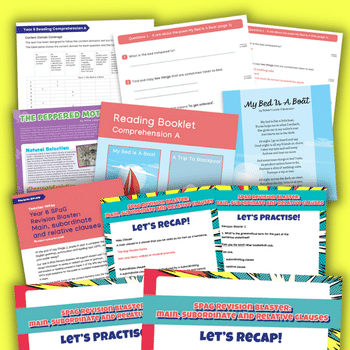SATs reading paper – 2024 review and hints for 2025 success

With the 2024 SATs reading paper fresh in our minds, we consider its effectiveness as an assessment tool and share key strategies to help pupils tackle the 2025 paper…

- by Teachwire
- Classroom expertise and free resources for teachers

Join us as we reflect on the challenges of the 2024 SATs reading paper and explore practical tips for helping pupils succeed in 2025…
Tips for 2025 SATs reading paper
Shareen Wilkinson pulls out some secrets to 2025 success…
The 2024 SATs reading paper had mixed reviews. Some schools reported that it was easy and accessible, while others found it challenging.
One thing it does do though, is provide some great pointers on how to teach for SATs success in 2025.
Drip in SATs reading paper style questions
Repetition is vital. The more pupils encounter test-style questions in a practical and fun context, the less fazed they will be when it comes to the actual test.
In practice, this simply means that when completing a reading lesson, adjust your questioning. This is not about testing pupils, but about cleverly adapting the questions you ask.
Here are some examples used in the 2024 KS2 SATs reading paper:
- Find and copy…
- How can you tell…
- This suggests…
- Tick two…
- According to the text…
Let’s take an extract from The Final Year by Matt Goodfellow, as an example:
- All I remember is from
- somewhere really deep down in me
- I feel a darkness risin’
- but like a hot darkness
- like fire and smoke all mixed together
- and my fists are flames
- and the next thing I know
- I’m curled up in The Sunshine Room cryin’ and cold
- and, man, I’m tired so tired
- and my teacher Miss Nolan’s rubbin’ my back and
- the whole room’s in bits the whole world is.
When approaching the text with the class, begin by modelling reading comprehension strategies:
- Visualisation – What do you see at this point?
- Background knowledge – Does this section remind you of anything?
- Questions – Do you have any questions at this point?
Alternatively, you could use ‘I think, I see, I wonder’ to model the same concepts.
Then, adapt your reading comprehension questions. So, instead of ‘What is Miss Nolan’s character like?’, ask children:
‘Miss Nolan rubs the boy’s back.’ What does this suggest about her?
And rather than ‘How is the boy feeling?’, ask pupils:
How can you tell the boy is angry? Give two examples from the text.
Keep reading for pleasure and information
The way to develop vocabulary and background knowledge is to read a wide range of fiction, non-fiction and poetry texts on a range of subjects across the curriculum.
This broadens pupils’ experiences and ensures they have a rich vocabulary and knowledge to prepare for the demands of the tests.
In 2024, pupils’ knowledge of habitats, extinction and species are all aspects of the science and geography curriculums but can also be explored through extensive reading across the curriculum.
Pupils need to learn new ideas by building on what they already know. In essence, being familiar with a topic, not necessarily the exact topic in the SATs reading paper, enables pupils to access the paper swiftly because they are familiar with the content.
Explicitly teach test techniques
Teaching test techniques is sometimes addressed by giving pupils endless past papers to complete. This is nearly always (in my experience) an unproductive activity.
There is a place for pupils to experience what a whole paper looks like (explored later) but there is a benefit to explicitly teaching skills.
For example, pupils need to be clear about the question stems used in the SATs reading paper. They also need to have an in-depth understanding of the vocabulary.
The more complex inference questions this year focused on the pupils being able to decipher a person’s personality and compare it to others. Personality is the characteristics of an individual.
Question 39 in 2024, which was the last question, read:
Ruskin’s personality made him different from the hunters he met in the forest. Explain two ways in which his personality made him different from them, using evidence to support each answer.
Just under 33 per cent of pupils across the country answered this correctly and 76.5 per cent attempted the question.
To gain the full three marks for this question, children would need to understand that they must find a point with evidence and then find another point.
I teach pupils PEPE as well, just in case they miss a piece of evidence.
| Personality | Evidence example |
| protective / respectful non-violent (towards animals) ethical / law-abiding / not mercenary brave solitary reflective | He is protective, because it says, “They asked me if I had seen a leopard. I said I had not.” |
A salient point to note is that pupils do not need to write long essays. They need a point with evidence and then another point. Work around character’s actions with a focus on ‘show not tell,’ is beneficial here.
Here is an example of a three-mark answer:
He is protective (point), because it says, “They asked me if I had seen a leopard. I said I had not.” (evidence)
He is brave. (point)
Explicitly modelling how to give answers and using mark scheme examples for discussions are all sound ways of teaching three-mark answers.
Use fun and interactive revision strategies
Who says that revision must be dull? I often hear this and it doesn’t reflect my experience at all. Teaching inference skills can easily be covered by exploring the thoughts and feelings of characters in pop songs, rhymes and online videos.
The best way to consolidate learning and enable retrieval practice is to get pupils to teach other pupils in the class.
Give them an area of focus and let them create a poster, worksheet or digital presentation that they will present to the rest of the class.
Being able to fully explain a concept is beneficial for embedding knowledge into the long-term memory.
Explore and discuss language
In 2024, many questions focused on exploring language, rather than words in isolation. When reading, explore metaphors, similes and personification and discuss what images they convey to the reader.
Draw on strategies like visualisation and maximise spoken language opportunities to unpick texts. For example, what do you think that means? Do you agree with that? What images can you see?
Trending
Give pupils experience of the test papers
Whilst it’s important to continue to teach and drip test-style questions throughout Year 6, children still need to be aware of the timings.
This is especially true for the SATs reading paper, where they have 60 minutes to read through and answer questions for three or four texts.
Rapid retrieval through skimming and scanning is needed for this; just try to keep test experience to a minimum.
Work on whole-school strategies
The more all teachers see the test papers and have CPD opportunities to increase their subject knowledge, and the more senior leaders promote a whole-school responsibility for SATs, the higher the likelihood of success.
Shareen Wilkinson is a successful educational author and adviser with over 20 years of experience in education. Currently, she serves as executive director of education for a high-performing multi-academy trust, where reading at KS2 exceeds national averages. Browse more SATs resources.
Is the SATs reading paper fit for purpose?
Alex Quigley breaks down the 2024 KS2 reading paper and wonders if there’s a better way…
The first text for children to read in the 2024 KS2 SATs reading paper was an informational one, entitled ‘Streaky and Squeaky’. It discussed the wildlife of Madagascar, focusing in particular on the streak tenrec.
Like many informational texts, it presented a unique topic, unlikely to have been directly taught in the primary school curriculum.
This approach is common in general reading comprehension assessments. It seeks to assess a valid, generalised reading ability, separate from expectations of what has been explicitly taught in the national curriculum.
Along with tier 3 vocab (deforestation, population), the streaked tenrec text combined tricky academic language (soft-bodied invertebrates, stridulation) with more age-appropriate ‘book language’ (confused hodgepodge, marvellous streakiness).
Additional text features were also included to guide the reader.
An unlevel playing field
Stronger readers would likely have encountered more tier 3 words in the curriculum than their less able peers, along with other rich language experiences.
As a result, those readers should have been better able to link them together into rich schemas of knowledge – that is to say, inferring more meanings than a reader who was not already familiar with them.
In this regard, the SATs reading paper is what E. D. Hirsch describes as a ‘knowledge test in disguise’.
Of course, pupils had three such texts to grapple with, and so the SATs become a demanding test of fluent and knowledgeable reading.
Over 2,000 words, across the reading assessment, need to be cohered quickly into meaningful understanding; those schemas matter.
SATs reading paper alternatives
No assessment is perfect – and the KS2 SATs reading paper certainly isn’t. So, we should replace it with something better, right?
Topic known in advance
There has been a call to change the SATs assessment into a reading test where the topic of what is being read is already known and pre-taught in the curriculum.
For example, schools could be told that pupils will be tested using texts about the Amazon rainforest. This could create some equity for those pupils who don’t possess the background knowledge of words and the world, accumulated via lots of prior reading and learning.
However, doing this would shift the nature of the assessment to being one more squarely testing teachers’ ability to teach a reading curriculum successfully, rather than children’s reading ability and knowledge of the English language.
It doesn’t take too big a mental leap to see schools narrowing the curriculum to hot house those topics announced for the SATs.
A term of Year 6 (then 5, then 4…) could become devoted to learning everything about the Amazon – with pupils mired in endless SATs-style mini-texts.
The risk of any shift that privileges a knowledge-rich reading curriculum, is a curriculum narrowed by expediency.
Reading fluency instead
A yet more radical solution, proposed by some experts, is to jettison reading comprehension assessments altogether.
Perhaps we could replace them with reading fluency assessments, which are a handy proxy for reading ability. But what if we then forget to emphasise the meaning of the language?
We may unintentionally create a focus on speed reading and oral reading, but miss a vital focus on comprehension (which would hamper the test’s validity).
Reimagining the SATs reading paper
There is no easy answer for getting the right reading test format. Reading is a complex skill, comprising a wealth of subtly interlinked knowledge and strategies that are developed over years, inside and outside the classroom.
Tests usually struggle with such complexity, and they offer us only pale approximations of the authentic reading process.
A key answer for me is to step back from the test format itself and aim to appraise successful readers and skilled reading.
The biggest misconception about the current iteration of the SATs reading paper is that practising lots of short texts, and answering questions that retrieve information and summarise ideas, improves your reading ability.
But doing this can steal so much curriculum time that pupils aren’t doing the wide reading necessary to actually become skilled and knowledgeable readers.
The fundamental problem is that you don’t become a skilled and knowledgeable reader by undertaking pale imitations of reading comprehension tests.
That occurs when you read widely. You summarise, but you talk about texts in a dynamic way that lets you read on and on.
The elements of success
There is no one solution to complex reading, but I think there are five key interlinked elements, which I have outlined below.
To do all five well needs planning and time. It probably needs the space created by not imitating the assessment over and over.
In short, if practising the assessment stops you doing lots of 2, 3, 4, and 5, then just stop. It is fool’s gold!
- 1) Get ‘learning to read’ right. It all starts with early reading experiences, good phonics instruction and developing pupils’ phonemic awareness. They need to lift the sounds from the page until it appears effortless.
- 2) Bridge to comprehension with reading fluency. Children need lots of practice of reading aloud and fluency. Happily, this builds nicely on phonics approaches, and bridges to plenty of quality book talk that develops comprehension.
- 3) Do lots of wide, rich reading. The recent focus on curriculum has foregrounded how children learn by building knowledge and connecting those schemas in helpful networks. The key here is reading lots of ‘Goldilocks texts’, which are neither too hard nor too easy. I think we need to step away from the worksheets and five paragraph texts; children need to read full books. If they overlap in ‘reading clusters’, so much the better. Only then will pupils make the connections and deal with the complexities that stick long in the memory.
- 4) Teach strategies for tricky texts. When you are reading a ‘Goldilocks text’, you need to be strategic: questioning, clarifying, summarising. These strategies don’t need to be over-taught; they should be focused on the text at hand, steering some rich book talk as a helpful scaffold.
- 5) Cover explicit and implicit vocabulary. It can be very useful to explicitly teach vocabulary like ‘deforestation’ and ‘population’. These are high-value words that initiate lots of connections and schemas of knowledge. In addition, by teaching a small number of words explicitly, we help foster a curiosity for words.
Alex Quigley is the author of Closing the Writing Gap. A former teacher, he is now the head of content and engagement at the Education Endowment Foundation, alongside his personal writing and training for teachers.










